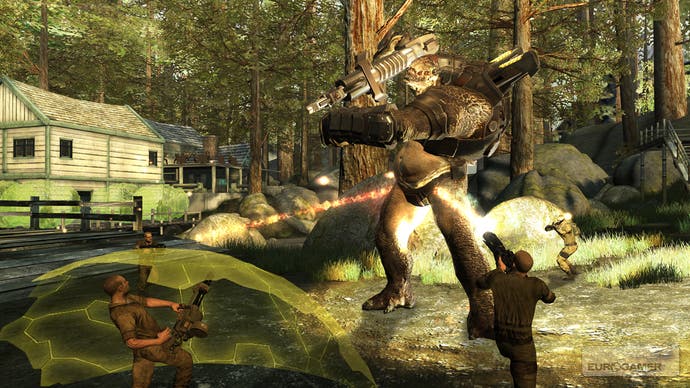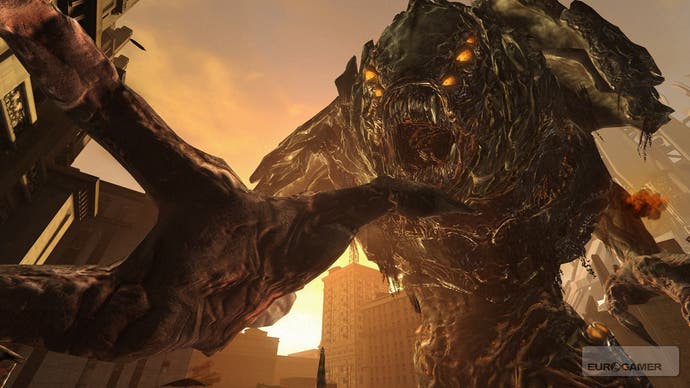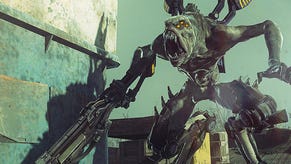Resistance 2
Fight the good fight.
The campaign mode is hefty in size, at least for the genre, offering around ten hours for an averagely skilled player on normal difficulty. It's well-paced, and throws up plenty of varied scenarios to test your mettle. The story feels somewhat perfunctory, though no worse than any of its rivals, and even the predictable excursions inside enemy ships are more bearable than similar levels in other games, even if the sweeping alien architecture may leave you wondering if you're fighting the Chimera or the Covenant. Speaking of which, Resistance 2 is arguably more cohesive than any of Halo's single-players, and while the game never quite matches Bungie's highs, it never plunges to the same depths either. Even in a battle against an alien swarm that some will peg as a Flood rip-off, the challenge is more balanced, the outcome more interesting and the integration into the wider gameplay more satisfying.
Then again, Halo never got its highest marks for the solo campaign, but for the huge strides it made in first popularising and later defining console FPS multiplayer. Resistance 2 brings its own innovations to the table, though they're more evolutionary in nature. Insomniac's boast of increasing the number of simultaneous players for competitive games from 40 to 60 could well fall into a pit of PR bluster, were it not that the team has obviously considered ways to balance that many players rather than just bolstering the net code to allow more people in. Rather than having sixty people running around at random, these large-scale matches have their own dedicated mode - Skirmish - and players are split into a number of competing squads. Each squad has objectives to meet; objectives that are also being attempted by a rival team. So rather than one giant battle, you get a series of smaller confrontations all taking place on the same map.
It's either a stroke of genius or a fiendish cheat, depending on how you view the world of online play. Certainly, depending on the map and objectives, there will be times when you won't even notice that there are dozens of other people elsewhere in the same game. When the combinations click, however, the result is quietly impressive - a traditional and accessible multiplayer that convinces you you're taking part in a larger war. It probably won't be enough to impress Warhawk fans, but in the realms of FPS it's a shrewd idea.

Resistance 2 saves its most innovative ideas for co-operative play, however. The traditional answer would be to let players go through the single-player side-by-side, but instead, up to eight players join forces and take on a series of miniature campaigns that run alongside the main story, suggesting some of the other events that are occurring while Hale does his hero thing. There are six maps, drawn from this game and the original, with a set number of different objectives attached to each. The game randomly selects and shuffles three of these objectives for each game, throwing in some boss encounters to spice things up further.
You choose from three classes - Soldier, Spec Ops and Medic - with each relying on the other two for success. Soldiers are tough, well-armed and can use their Wraith mini-guns to create mobile shields to protect other players as you push forwards. Medics can heal wounded teammates, but rather than removing them from active duty the game allows them to join in the combat as well - drawing health from enemies to heal themselves. Spec Ops troops can fling fresh ammo to other players but also deal in heavy damage, making them the frontline choice for larger boss battles.
Each also has an optional "Berserk" - a gameplay buff activated by filling a meter with enough kills - and these offer benefits, like Prototype Ammo, which allows Spec Ops players to dish out extra-powerful ammunition; Ring of Life, which creates a healing circle around a Medic; and Overload, which allows a Soldier to take enemies with him by exploding upon death in a manner similar to Call of Duty's Martyr perk.

Each class earns experience based on successful execution of their roles, as well as completed objectives and defeated enemies, and this then plays into a simplified levelling system. New abilities and Berserks are unlocked as you advance through the ranks, while "grey tech" retrieved from fallen enemies can be used to purchase new armour and weaponry, which customises your character's appearance. This currency can be carried from one class to another, so you can use a successful Soldier character to build up a Medic on the same account without tiresome grinding each time.
It's a simple system, elegantly executed, and by keeping the classes to just three it creates an instinctive symbiosis between players. One class cannot succeed alone, so working together is your most attractive option simply because it works. The only potential downside is that you will, inevitably, run out of combinations of maps and objectives sooner or later. Some may also mourn the lack of a traditional co-op mode. It'll take you a decent amount of time to explore all the co-op options, however, and even more if you want to level up each class and earn all the bonuses, medals and other rewards for good play.
Overall, multiplayer is the satisfying other half to a formidable package, and Resistance 2 is precisely the sort of exclusive game that the PS3 needs. Improving tenfold on its predecessor in almost every area, it not only belongs on the shopping list of existing Resistance fans, but those who were underwhelmed with the original will also want to check it out, and then fight for it on the internet. It's the way of the warrior.



